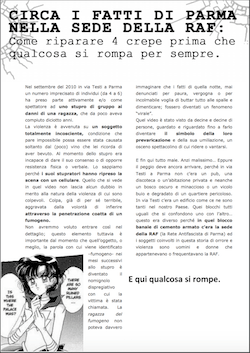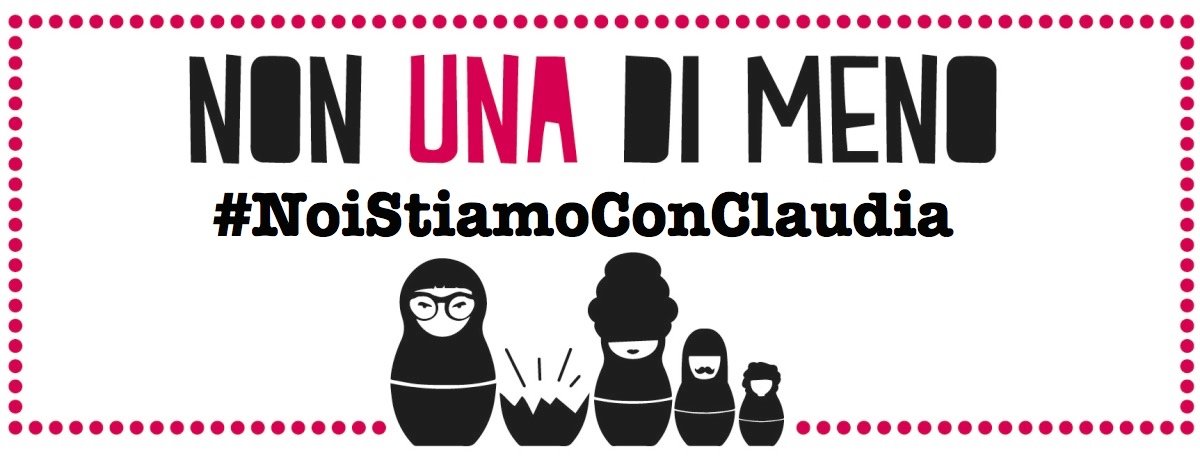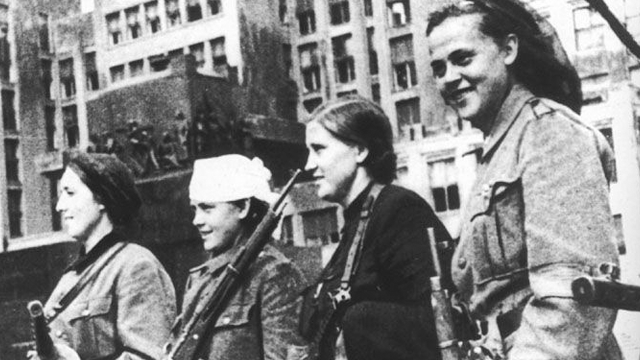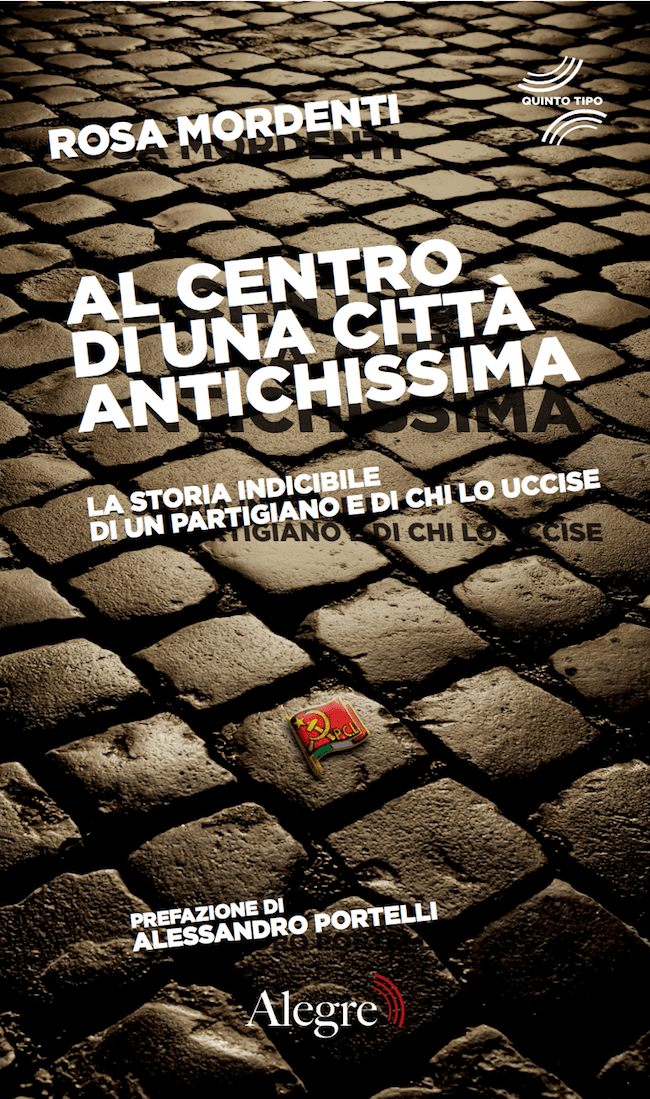An analysis of how rape culture permeates yesterday and today's right-wing narrative, and of how anti-fascism sometimes failed to face it, with violent consequences. Part 2 of an article by the Nicoletta Bourbaki collective, published on Wu Ming's website.

To read the first part of this piece, see here.
Content Note: This article contains discussion of rape and violence.
6. The narrative tics of the Ghersi case
All these narratives are mixed and hybridised in the story of the murder and rape of Giuseppina Ghersi. It becomes a mythological episode, where all the archetypes regarding partisan violence, none excluded, are present as narrative tics that reveal the lack of historical accuracy in establishing the facts and the desire to move and horrify readers rather than inform them.
It’s no coincidence that two of the images most used to illustrate the horrors of the Resistance are associated with Giuseppina: the dead girl with the white dress and the girl with an M painted on her forehead escorted by partisans, even if those images appear to be of different individuals - the two girls don’t look remotely alike, even at a very quick glance.
In the revisionist narrative - handed down by makeshift historians or by researchers who refuse to follow the historical method, and entrusted to the hands of the far right - all the victims of partisans were raped. They must have been raped. Because that is the inevitable destiny of the woman, a fragile subject, in a war context, and because that’s how those who today are so worried about honoring their memory would have treated them then, if they were on the other side.
This is clear if you look at the ease with which people close to the far right threaten any woman generally considered as leftist with rape - or rather every woman and that’s that.

From this perspective, Giuseppina Ghersi cannot be a young woman who voluntarily and in accordance with her age joined the fascist movement, without understanding its horror and contributing to its power. No, she must be infantilized, the ‘poor Pinuccia’, shown not in more recent photos but in her primary school photo, imagining that it was taken in the same school where she wrote her little essay for the Duce - that she probably never wrote, but so what? Or portrayed in the little white dress of her First Communion, with the aura of a little martyr and evoking her failed destiny to become a bride, the one and only possible climax of her future as a woman.
And so the violence against her, as the daughter of everyone, becomes violence against us, the social body, and not her individual body.
Before the 1996 reform of the Italian Penal Code - issued by the fascist Minister of Justice Alfredo Rocco, but framed by legal experts who after 1945 would boast of their liberal education - crimes of sexual violence were actually conceived as crimes against the community rather than the individual, classified as ‘crimes against public morality and common decency’.
There has been a legal evolution, but it looks as though it is subject to relapse and regression. Commenting on the case of a sexual assault against a German woman in Rome on September 22, 2017, the head of police Franco Gabrielli immediately shifted the focus to the population’s sense of security and to the damage done by journalists in defining the victim as a tourist when she was in fact a homeless person. He said, ‘We are talking about a person living in a state of marginalisation and degradation, which is still serious, but it’s not like having a city in complete disarray.’
And here is the umpteenth external hitching post for rape, not significant in itself but a weak point in the public’s peace of mind, one that is linked to degradation, to night life, to women’s stubborn habit of not living safely and to the existence of housing squats.
On September 13, the newspaper Il messaggero launched a campaign against sexual violence where it invited Rome’s mayor Virginia Raggi to increase the number of security cameras and the military, to ensure public lighting and to make citizens aware of services like taxis for women. Because it’s not that there is a predatory view of women, reduced to a subordinate subject, behind rape, but that women lack awareness regarding ‘men’s ancient habit of protecting women’, who, especially when young, ‘need a social context surrounding them of a protective armor made of sympathetic eyes following them’ (here). Women’s freedom becomes only ‘in principle’ and must surrender to common sense, to harsh reality or, as Lucetta Scaraffia calls it, to ‘real life’.
This disconnects rape from the gender issue, and so rape can be used in any form of media in order to inflame public opinion, or reassure it.
If girls and young women stay at home or are escorted home by fathers and boyfriends, we will have fewer rapes.
If we stop migrants landing and kick them out, we will have fewer rapes.
If we clear up the gypsies, we will have fewer rapes.
If feminists stop demanding utopian equality, we will have fewer rapes.
Rapes only exist in these narratives to be used against women, and without any concern for their suffering.
This has been the case even where you would least expect it, in a space where people who call themselves anti-fascist hang out. It shows that macho and sexist culture is everywhere and that we must never, in any place and situation, let our guard down.
7. The ‘anti-fascist’ rape in Parma
Parma, September 2010. In a building in Testi Street, an unknown number of people rape an eighteen-year-old girl. Some of them are actively involved in the rape (three people sent to trial and then convicted in the first instance); the others, who ‘just’ watch, either never will stand trial or will have their case dismissed in a summary judgment.

[Read the flyer about ‘How to repair 4 cracks before something breaks forever’, distributed by anarchist comrades in December 2016 (pdf). ‘A rape is still and always a fascist act, even if the perpetrator claims to be anti-fascist […] Everyone who rapes is a fascist and we fight him as a fascist and a rapist.’]
The victim is an unconscious teenager, raped and penetrated with a smoke bomb. This kind of detail is worthy of porn news, we are well aware of that. Unfortunately, we have to mention it in order to understand the nature and gravity of the events. After the sexual assault, Claudia – a name chosen to protect her identity – becomes the smoke bomb girl in Parma, and their attackers share her rape, filmed with a cell phone, with friends and acquaintances.
The smoke bomb girl, who no longer has a name or an identity, becomes a target for sexual abuse and harassment, but this is just the beginning. Three years later, the video gets into the hands of the Carabinieri. They summon Claudia and force her to look at her rape from the outside, frame by frame. At the trial against her rapists, as she says in an interview to the paper Il fatto quotidiano, the video is projected for hours, even with instant replay, in order to prove that her body, still as death, was consenting, based on freeze-frames of her hands and legs shaken by spasms.
Claudia does not want to report the attack to the police but this kind of offence automatically triggers a criminal prosecution. That’s another irrelevant detail, but it plays a part in the story told about her rape, made up by others, primarily her rapists.
Because the headquarters of the RAF, the Rete Antifascista (Anti-fascist Network), are in Testi Street in Parma. Claudia was raped by men who called themselves anti-fascists, men protected by women who until a few hours earlier she would have called comrades.
In a place said to be devoted to anti-fascist ideals there is no moral condemnation for those who raped, nor sympathy for the victim.
As in the worst screenplays, a narrative is constructed from the first violent image that traps Claudia in the role of victim/perpetrator. Her rapists do as they please without let or hindrance, not in the least worried that there is a piece of evidence that could ‘nail’ them, as journalists say. But the video of the ‘smoke bomb girl, in the distorted story told by people who distribute it without shame or guilt, adding savagery to savagery, no longer shows a rape. The violence inflicted on a woman so unconscious that she appears dead is presented as a record of a textbook virile performance, a ‘typical’ female and guilty passivity. Not ‘what we have done’ but ‘look at what she let happen to her’.
The video passes from screen to screen among the attackers’ circle and, by sharing, it reaches other towns. The rape remains undetected. News of it doesn’t spread inside the movement in Parma and anywhere it does turn up, it’s not seen as a rape or violation or as something, human or political, to face seriously and immediately. The rapists leave the anti-fascist RAF network. Some of them leave Parma.
In August 2013, a cherry bomb blows up in front of the Casa Pound office. The investigation targets the network of occupied social centres and their users, which includes members of the RAF, the anti-fascist network. Summoned by the Carabinieri, Claudia says that she distanced herself from the RAF after ‘a very upsetting situation’. They already know about the ‘very upsetting situation’: it came out when some militants were searched. The rape video is still on their phones, more than three years later.
A gang-rape complaint is automatically triggered, but the rapists and others close ranks and nobody reveals their identity. It is up to Claudia, who has only a few confused memories of the night of the rape, to identify them from the video: that means house arrest for Francesco Cavalca, 25 years old, Francesco Concari, 29, and Valerio Pucci, 24.
Those arrested try to convince Claudia to mitigate her statement and launch a smear campaign against her, in response to her refusal.
‘They showered me with insults because I made a statement, calling me a snitch for letting the cops in the social centres. They even spread the rumour that I got together with fascists and that I went around with CasaPound people.’
Now that the rape is there for all to see, denying it needs a new narrative shift. It is not a story of rape any more, it’s the story of an informer, or even worse, of a fascist informer. The violence suffered by Claudia disappears by magic once again, thanks to a dear old ultra-right war horse: the real fascists are the anti-fascists.
Claudia even tries to excuse herself: ‘I never reported anybody. I wanted to protect my parents and I was embarrassed by a violent attack that the “comrades” hit me with. The Carabinieri went to them because they saw the video on the cell phone.’
It takes six years from the ‘anti-fascist rape in Parma’ for the movement to question itself about the sexist culture and gender-based violence that still permeate it. On the eve of the trial, this questioning starts, based on the premise that rapists cannot be anti-fascists.
The news appears in the mainstream media which talk rightly about omertà and connivance, but the political objective of exploiting the story is obvious, shifting the focus from gender-based violence and teasing the morbidity of the readers with details such as the smoke bomb, in order to paint a picture of the general degradation of the occupied spaces. And where women will never be safe, not in Parma nor in the capital (see Gabrielli’s comment above about the rape of the German homeless woman in Rome). There are no pictures to publish but the story of this rape is told in a such a cinematic way that it leaves nothing to the imagination.
In November 2016, a new line of inquiry opens, with the indictment of three young men and a young woman for aiding and abetting: ‘A.S., 23 years old, and D.D.P., 29 from Parma; R.G., 28 from Reggio Emilia and M.D.P., 26 from Milan’. The four people, Parmapress24 reports, never touched the girl but ‘had tried to convince her to change her story’, had made ‘threatening telephone calls’ and sent ‘messages’.
In July 2017 Francesco Concari, Francesco Cavalca, and Valerio Pucci are convicted in the first instance as perpetrators of the rape (4 years and 8 months for Concari and Cavalca, 4 years for Pucci).
Immediately after the sentence was passed, the Gazzetta di Parma reports a statement made by Claudia. These perhaps aren’t her exact words but people close to her confirmed that the content matches what was important to say:
For all these years they have called me a snitch thousands of times. I have been slapped, insulted, and thrown out of bars and clubs frequented by Concari, Cavalca and Pucci. They even threatened me. And maybe that's what hurts the most. This network of silence, which I never expected. The behaviour of the lawyers during the trial: they dissected my life, as if it were my fault. As if I wanted everything that happened to me.
If the word anti-fascism has a meaning – and for us it has - no-one in this story is and never was anti-fascist: those convicted are not anti-fascists and nor are those who covered up for them or simply ignored them, leaving Claudia alone.

8. Anti-fascism and gender issues, an old loose end
These days the headquarters of the Anti-fascist Network, the RAF, in Testi Street, Parma, are closed.
The issue of gender violence and sexist culture lies a long way away, out of focus, always on the edge of the frame, even in antifa places where there is an inability to read it and recognise it. This inability takes us back to the years immediately after the Liberation.
It is unreasonable to say that the struggle for the Liberation, or specific areas of it, is responsible for the range of out-of-control individual actions, private vendettas and, in particular, hateful acts of violence against mostly young women. Such unacceptable actions are visited upon the female body, which is reduced to a ‘thing’, just an instrument used to damage the honour of the male enemy. These actions also bear the stamp of a more general gender culture: the patriarchal culture of males growing up and educated in the united, Catholic, liberal Italy of the fascist era. Seen in the context of this culture, the different forms of the spirit of resistance represent discontinuity.
Having said that, a basic problem in the relationships between men and women has always been present within the resistance movement, not to mention the Communist Party. Pavone explains how women were relegated by default to secondary or supporting roles.

Excluding the many contradictions in how men saw women at the time, and if we let women’s choices on September 8, 1945 speak, we have the following: 35,000 fighter partisans, 20,000 patriots, 70,000 registered with Women’s Rights groups, 623 fallen in battle or shot, 3,000 deported, 4,400 arrested. These are low estimates, according to Anna Bravo, which tell us how the liberation movement also represented the aspiration for emancipation.
Yet, women were asked not to take part during the Liberation demonstrations:
Partisan women paraded, in men’s clothes, with the men, and here and there some people started to murmur “My poor Italy!” All the citizens started to wink because these young women had such faces and such ways of walking. The commanders were under no illusions about this point. On the night before the partisans came down into the town, they gave the order that the partisan women had to stay on the hills. The women told them to fuck off and threw themselves into town.
(Beppe Fenoglio, I ventitre giorni della città di Alba, The 23 days of the city of Alba, mentioned in C. Pavone, Una guerra civile, p. 444).
In that ‘murmuring’ and ‘winking’ there is a whole mental universe.
The invisibility of partisan women helps to put them back in line in post-war society, which wants them as irreproachable mothers and wives as before, even - and especially - if they have a political role. Over time, the lack of photographic evidence of female armed struggle during the Liberation helps to spread the image of the nurse-partisan and indirectly fuels overexposure of ‘female’ victims of the Resistance.
After the war ‘the uneasy relationship with brigade comrades is one of the subjects people still talk about; they had to recognise the women who fought alongside them and overcame fascism, but “it is not a recognition with deep roots”’ (cf. Ponzani, p. 284; the latter phrase from a testimony given by Ida Camanzi).
In the political context of the post-Liberation period, where calls for change slow down and are impeded, as the liberating forces are regularised, equal rights in every sphere of social life are still far off. And women who deviate from their expected role, who make themselves visible, trigger ostracism by men, if not out-and-out stigmatisation.

Rosa Mordenti in Al centro di una città antichissima ([i]In the heart of a very ancient city[/i, ]2017) reconstructs the story of a communist militant, found guilty of the murder of her separated husband, a partisan and journalist for the L’Unità newspaper. Guilty, even before the murder, of rejecting her role as a mother, turning her back on the happiness of the modest domestic lifestyle that her husband could grant her, being in love with another man, liking dancing. A bourgeois pleasure, dancing, which reveals her social background and reduces her to the archetype of the female traitor (beautiful, a lover of luxury, lascivious) which echoes the descriptions of collaborators.
Rosa Mordenti writes that normalisation ‘always starts when women return to their homes’. If the Resistance is a time of suspending and reconfiguring roles that allows and tolerates the active participation of women, it is an exception that is normalised with the return to customary patterns. Excluding the new rights acquired through democracy and enshrined in the Constitution, this especially concerns the process of female emancipation. Such action, sending women ‘back home’, is the convergence of long-term cultural practice and new conformism, cutting across political force and commonsense.
Twenty months of resistance against twenty years of dictatorship cannot change a long-established mentality and bring about profound transformation in a country. As Alberto Cavaglion writes in La Resistenza spiegata a mia figlia ([i]The Resistance explained to my daughter[/i, ]2005, p. 43):
In the conditions in which it takes place, the partisan war in Italy can only be what it can be, without accusing it of not having been what it could not be, nor glorifying it for what it could not have been.
The media image of Maria Luisa, the main character of the narrative hybrid by Rosa Mordenti, dates back to 1952 but it seems to have been written the day before yesterday. Victim or enchantress-murderess, a woman has no other way to stop being invisible and even then the story she has to tell is not enough. We need an image and not just any image but one that combines beauty and horror and patience, if it is a fake, if it is a mere illustration.
When the story of a rape is told, nine times out of ten a photo of a woman curled up is used, with her face hidden between her folded legs or shielded by her hands in a silent mask of despair. A photograph that has no connection with the victim and that does not reflect her age or identity but one that supplies the ‘ideal’ picture that a raped woman must be able to show the world in order to be believed and accepted.
A picture where attractiveness, youth and weakness cannot be missed.
The original article in Italian is published on Wu Ming Foundation's website Giap.






Comments